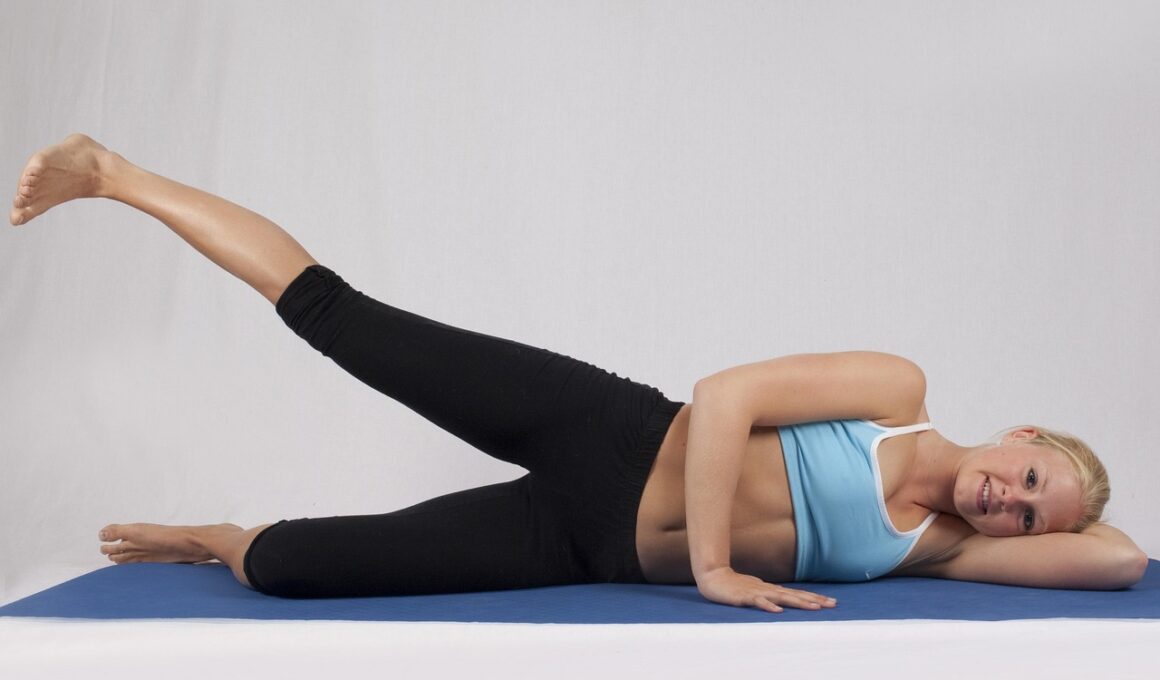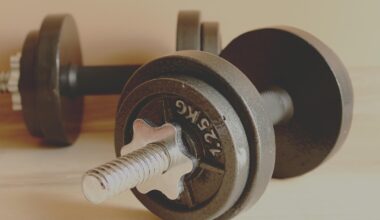Improving Back Flexibility to Achieve Advanced Gymnastics Moves
Enhancing back flexibility is crucial for mastering advanced gymnastics skills, enabling athletes to perform with greater grace and precision. Flexibility aids in injury prevention, as well as improving overall kinetic chain function. Athletes often require a combination of strength, endurance, and flexibility to execute complex maneuvers. Techniques such as dynamic stretches and static holds can significantly enhance flexibility around the spine. A proper warm-up is vital before commencing strenuous activities. Maintain consistency in your routine while gradually increasing intensity. Important stretches include the cobra pose, cat-cow stretches, and deep forward bends to maximize the stretch in your back muscles. Using tools like foam rollers and stretching bands can offer added assistance, promoting deeper tissue release and flexibility. Furthermore, incorporating yoga into your training regimen may provide significant improvements in flexibility, posture, and balance. Always listen to your body regarding discomfort levels, aiming for a gentle stretch rather than extreme tension. Moreover, tracking your progress through a fitness journal can motivate you to continue pursuing your flexibility goals in gymnastics, ultimately leading to successful performance on the mat or in competition settings.
Multiple factors contribute to effective back flexibility, making it essential to explore various techniques and methods. Strengthening the surrounding muscles aids flexibility as well, establishing support for the backbone. In addition to stretching activities, engaging in movements that activate the core muscles is vital. Perform exercises targeting the lats and lower back regularly, ensuring they synergistically function with flexibility efforts. Resistance bands can be particularly effective for incorporating strength training while simultaneously enhancing flexibility. Incorporate modified Pilates movements into your routine to balance strength and flexibility, as well as develop a stronger connection with your body. Moreover, proper breathing techniques are essential for both flexibility and strength-building exercises. Deep breathing encourages relaxation, which is key to allowing muscles to relax during stretching. Regularly practicing mindfulness can help athletes foster a positive mindset, creating a nurturing environment for improvement. Individuals should also consider enlisting the help of a coach or trainer who can provide personalized feedback and adjust exercise intensity as needed. Ultimately, an effective, holistic approach combining flexibility and strength training will promote a range of gymnastics skills, leading to performance breakthroughs in competitive contexts.
Dynamic and Static Stretching Techniques
Both dynamic and static stretching are essential components in enhancing back flexibility. Dynamic stretching improves blood flow, progressively preparing muscles for activity. When warming up, athletes should focus on movements that simulate their routine, such as high knees and arm circles. These help establish a range of motion for the back while also activating muscles. Static stretching, on the other hand, should follow the workout or serve as a standalone session. Holding stretches like the seated forward bend or bridged back stretch for 20-30 seconds promotes muscle elongation and relieves tension. A combination of both types of stretching enhances flexibility, and awareness of proper form is crucial. Engaging in faulty techniques can lead to injury, rather than improvement. In addition to duration and intensity of stretches, ensuring a comfortable environment will also aid flexibility progression. Gradually growing one’s flexibility takes time and necessitates a focused, intentional approach. Consistent routines and mindful practice cultivate substantial improvements over time. Incorporating periodic assessments can help track flexibility milestones, serving as encouragement and motivation as athletes progress in their gymnastics journey towards advanced moves.
A significant strategy for advancing back flexibility involves creating a personalized training program. Individual needs vary, so developing a structured approach suited to personal goals is vital. Begin by assessing your current flexibility levels through self-assessment tests. Include specific targeting exercises focusing on the back, searching for any areas needing improvement. Allocate rest days strategically to prevent overtraining or injury. Consistency is key; commit to a well-rounded plan that embraces strength, endurance, and flexibility components. Adjust your schedules regularly, adapting to any changes in your daily life or training. Incorporate variety by integrating different activities, such as dance or martial arts, to keep the routine engaging. Furthermore, maintaining a balanced diet can enhance recovery and overall performance. Nutrients like protein and hydration play crucial roles in muscle recovery, ensuring that athletes feel their best while training. Engaging in social aspects, like participating in group classes or workout sessions, can also boost motivation. Surround yourself with supportive individuals who share similar goals. This camaraderie fosters a positive mindset while maintaining accountability throughout your flexibility improvement journey in gymnastics. Continuous evaluation and adjustments solidify significant long-lasting results.
The Role of Core Strength and Stability
The interconnected relationship between back flexibility and core strength cannot be overlooked, as both elements contribute to athletic performance. A stable core serves as a foundation, enabling smoother movement patterns during gymnastics routines. Engage in exercises like planks or leg raises that promote core activation while minimizing strain on the back. Emphasis on eccentric control during movements will greatly enhance overall stability and flexibility, reinforcing a connection between core strength and flexibility improvements. Moreover, developing specific stabilizer muscles within the body can enhance the effectiveness of flexibility training. As flexibility increases, athletes can better control their movements, reducing risk of injury. Conditioning the core also provides a solid base to leverage when promoting spinal flexibility through various stretches and exercises. Always prioritize engaging your core during flexibility routines to inspire better technique and outcomes. Assess functional movement patterns consistently, enabling awareness of how core strength impacts flexibility. Education surrounding the importance of this connection fosters informed training habits, allowing one to reap the rewards of hard work. Both core stability and back flexibility work together harmoniously to create a strong, agile gymnastics athlete poised for success.
Additionally, it’s essential to incorporate rest and recovery strategies into flexibility training. Overtraining without adequate recovery may hinder progress, leading to burnout or injury. Scheduling rest days, listening to your body’s signals, and providing time for muscles to recuperate are key components in any effective training plan. Implement active recovery techniques, such as light yoga sessions or gentle walks, to promote blood flow while encouraging recovery without excessive strain. Employing methods such as foam rolling will help release tight muscles and connective tissue surrounding the back, subsequently enhancing flexibility. Nutrition is equally important; consuming nutrient-rich meals supports muscle repair after workouts. Priority should be placed on hydration and incorporating healthy fats, proteins, fruits, and vegetables into daily diets. Furthermore, consider the mental aspect of recovery, as mindful practices like meditation can also help mitigate pressure and encourage focus on long-term goals. Establishing an environment where rest works harmoniously with training fosters sustainable progress toward back flexibility in gymnastics. By prioritizing both physical and mental recovery approaches, individuals will experience improvements across multiple components of their skill set, working towards mastering advanced gymnastics moves with incredible flair.
Conclusion and Final Thoughts on Flexibility Training
To conclude, enhancing back flexibility is a multifaceted endeavor, greatly enhancing gymnastics performance. By integrating various stretching techniques, personalizing training schedules, and prioritizing core strength, athletes can develop a robust and adaptive flexibility routine. It’s crucial to maintain consistency, being mindful of each element contributing to overall progress in flexibility. Engaging with supportive environments and utilizing influential resources will help reach set goals, encouraging motivation along the way. Moreover, understanding the connection between strength and flexibility will enrich training and increase performance potential. Always assess your journey, reflecting on improvements gained from committed training regimens. Take advantage of ongoing evaluations, adjusting techniques, and addressing emerging needs of your body throughout flexibility practice ensures optimal growth. Incorporate rest and recovery strategies to maximize body performance while maintaining a focus on mental well-being. Ultimately, fostering a sense of determination and dedication will propel gymnast’s success towards mastery of challenging moves. Stay committed to this journey, where continuous improvement brings athletes closer than ever to achieving their desired gymnastics ambitions and inspiring others along the way.
Always remember that gaining back flexibility is a process that requires time, patience, and an openness to learning. Seek out diverse methods to make your training enjoyable while challenging yourself. Keep your end goals in mind, acknowledging each small victory along the way. All these components combine to create a well-rounded flexibility practice that paves the way for excellence in gymnastics. Whether you’re a beginner or an experienced gymnast, investing in back flexibility enhances your overall performance and enriches your athletic repertoire. Your gymnastics journey uniquely builds skills, mental resilience, and physical strength as you work towards your goals. Celebrate progress, support fellow gymnasts, and foster a community that inspires collective growth. Embrace the journey for self-improvement, continually striving for advanced skills while remaining anchored in flexibility training fundamentals. Completion of each practice shouldn’t just be about the outcome achieved but also, the personal growth experienced during the process. Therefore, cultivate mastery beyond mere moves—it opens doors to endless possibilities in gymnastics, where flexibility plays an indispensable role in success and expression. Keep pushing the boundaries, and enjoy every step of the way!


